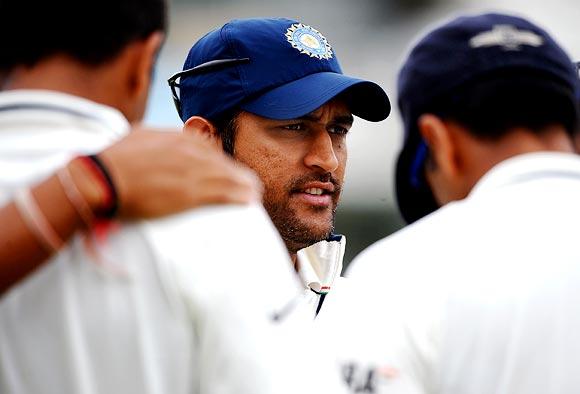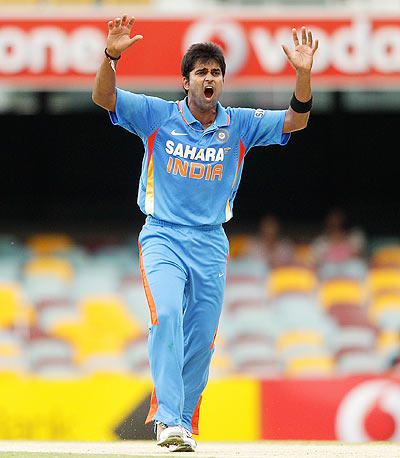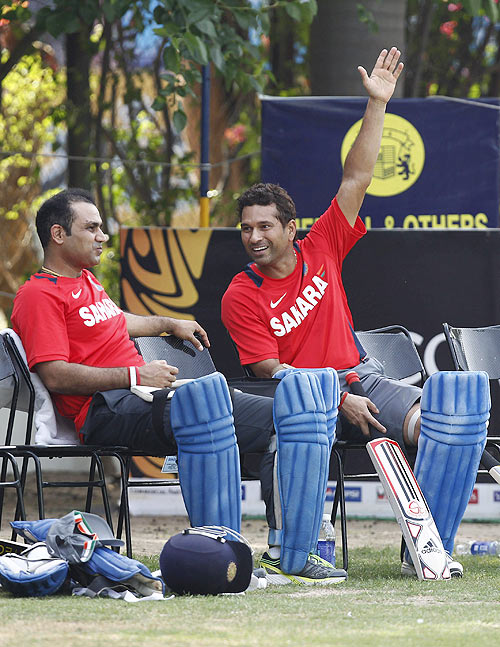While we wait with bated breath for the upcoming Asia Cup, Bikash Mohapatra dissects the disastrous tour.
Team India's early exit in the ongoing Commonwealth Bank series marks the end of a near three-month ordeal. It brings to a close another overseas tour that witnessed our much-hyped team return home empty-handed.
It represents another instance where the expectations of a billion fans remained exactly what they were to begin with (expectations).
The Virat Kohli blitzkrieg in Hobart -- in what turned out to be India's final match notwithstanding -- the team had to rely on an Australian win over Sri Lanka in Melbourne to secure a place in the final. It was not to be.
A Sri Lankan win in the above match ended yet another forgettable overseas tour by Dhoni and his men.
Flashback to 2008 -- the last occasion when Team India toured Down Under -- and you will recall the visitors, having lost the Test series marred by controversies, bounced back to win the CB series.
Fast forward to 2012, and hopes of an encore went up in flames, courtesy some insipid individual performances and lack of team effort. There's only one word to sum up Team India's trip to Australia this winter: disastrous!
Unlike 2008, when not many gave the visitors a chance, on this occasion, Team India was fancied to win their first ever series Down Under. The fact that the Australian team was going through a rebuilding phase, and had been erratic in their recent results, further strengthened India's case.
Two-and-a-half months later, suffice to say that Team India flattered to deceive. Yet again!
While MS Dhoni's team suffered a humiliating 4-0 thrashing in the Test series – having suffered similar fate in England last year, any hopes of redeeming some glory by retaining the CB series – the tournament was discontinued in 2008 only to be reinstated this year – vanished following a spate of vapid efforts.
There's no point in criticising this team -- not just because many (media and otherwise) have already done so, but also because it won't lead to change. The recent tours have clearly indicated one thing that the Indian cricket team will never learn from its mistakes. Neither will its fans, nor us, the media.
So what went wrong with Team India in the CB series? Let's dissect while we wait with bated breath for the upcoming Asia Cup.Not quite a happy ending
A major reason behind Team India's woes in the CB series was the propensity of its bowlers to leak runs in the final 10 overs.
If bowling is one of Team India's problem areas, bowling at the death is even a bigger concern.
Consider this!
In the opener against Australia in Melbourne, the team conceded 99 runs off the final 10 overs. The result: a 65-run win for the hosts.
Similarly, in their third match against Australia, at the Gabba (Brisbane), the Indian bowlers leaked a whopping 101 runs in the final overs, ensuring the home team a comprehensive 110-run win.
Again, at the Gabba, on this occasion against Sri Lanka, our bowlers gave away 91 runs in the last 10 overs. The latter won the match by 51 runs.
It is this generosity of its bowlers that cost the team dearly throughout the tournament -- a win and a bonus point as well. Add to it the fact that the opposite teams seldom capitalised in the batting Powerplay against us, and it doesn't speak very highly of our bowlers
It is also imperative here to mention that the three results (two wins and a tie) that ensured Team India's its points were achieved courtesy a miserly attitude of our bowlers in those matches.
Rotation is a virtue, and a vice
The policy of rotation is a double-edged sword, something that Team India learnt the hard way in the CB Series.
So we had Sachin Tendulkar or Virender Sehwag opening with Gautam Gambhir, and the three only played together on a couple of occasions -- once when Dhoni suffered a match ban following India's slow overrate.
The same was the case with the bowlers. The idea of resting a few players and including the reinforcements seemed a noble one, considering it was a long tour.
But to Dhoni's frailty, he tinkered with the team a little too much.
While it might have gone unnoticed had the team produced better results, the lack of it meant the idea would be considered a failure.
The fact that this policy didn't benefit certain players at all (Manoj Tiwary), and was applied to a few others sparingly (Rohit Sharma, Parthiv Patel, Rahul Sharma), further weakens its case.
On the contrary, going overboard with the rotation policy probably cost the team.Big men, bigger egos
Having a star-studded side isn't easy.
The fact that a majority of the multi-star cast offerings from Bollywood every year turn out to be damp squibs at the ticket windows provides a perfect analogy.
The same applies to the Indian team. All of its star players have inflated egos. In fact, the bigger the name, the bigger his ego.
In such a scenario it is difficult for the captain, more so if results aren't going your way and your big names aren't living up to their reputations.
Dhoni's predicament was no different.
His emphasis on rotation, preference for certain players -- preferably young or belonging to a certain IPL outfit -- and comments on the fielding ability (or lack of it) of the seniors, didn't go down well with the latter.
His rift with Virender Sehwag has been well-documented.
The fact that the BCCI had to step in (with a diktat), coupled with subsequent 'everything is fine' explanations by both the players concerned, provides further proof of the obvious -- that there are differences within the team and it is no longer restricted to the dressing room.Young ain't strong
Following the 4-0 humiliation suffered in the Test series, a few (mainly senior) players took the flight back home while a younger lot was sent as reinforcements.
Ahead of the T20s and the tri-series that followed, Dhoni was quoted as saying that the infusion of fresh legs will improve India's results considerably. It was a point well made. However, it was a tad premature.
While the bowlers got tired after a few overs, the batsmen rarely converted the ones into twos. With regard to the fielding, suffice to say, it is a perennial problem when it comes to Team India, and, therefore, doesn't deserve discussion.
Further, most of the players sent for the shorter formats, picked up injuries during the course of the tournament.
The above issues were highlighted, and rightly so, by a few Indian commentators. Something that clearly indicated, the solution to the team's many problems doesn't only lie in phasing out the older players with a younger lot. The need is to get players who are fit.
Youth doesn't essential mean fitness. Nor does age mean the lack of it. The likes of Brett Lee, Michael Hussey or, for that matter, Ricky Ponting have proved that fitness has nothing to do with age.
For Team India, though, it remains a huge worry, the age factor notwithstanding.





Comment
article